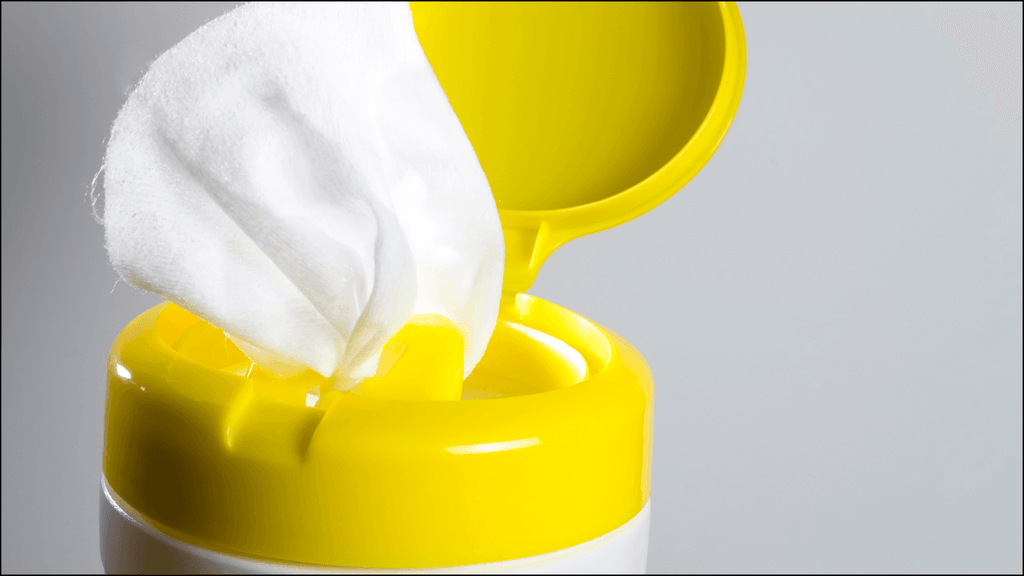UPDATE: To include information on the best nonwoven fabrics to use for making at home protective masks and PPE for the current COVID-19 / corona crisis.
Use this link to skip to that section on selecting non woven fabric mask materials.
In the past few weeks of TEXTILES 101, we have gone in depth into woven and knit fabrics. But, did you know there is one last type of fabric, that is actually the most popular type of textile in the world? They are nonwoven fabrics. So, what exactly is non woven cloth? Let's find out.
Spoiler: Nonwoven fabrics are the super sneaky non-sustaianble textiles that are everywhere because they make our lives convenient. But, if they are literally everywhere, why isn't anyone talking about them?
BUT BEFORE WE GET STARTED...
I love helping startup brand founders succeed, so I created a bunch of free guides that will help you with your business.
They won’t be free forever, so make sure to grab them while you can.
- CUT YOUR SOURCING TIME IN ½ - the industry sourcing doc you didn’t know existed but definitely need
- HOW MUCH DOES IT REALLY COST TO START YOUR BRAND – I have helped people with as little as $2,500 get started; here’s how…
- NO MORE EXCUSES – get the exact productivity system I use to get things done
what is nonwoven fabric?
definition of nonwoven fabrics
Fabrics made by bonded together and/or interlocking fibers. The resulting materials is essentially a web of fibers that does not have any specific organization the way a woven or knitted fabrics would. There are four ways to create a non woven web. They are mechanical, chemical, thermal, and solvent.
The name nonwovens can be misleading, indicating there is a difference between woven and nonwoven fabrics. But, in reality, the classification of non woven fabric is different from wovens AND knits..
history of nonwoven fabrics
In 1942 the first non woven fabric, interlining, entered the market. Interlining is the textile inside plackets on shirts, and other parts of garments. It gives garments added strength and structure. The process, of drylaid fibers, made a web formation of bound together staple fibers.
Around the mid 1950's Chicopee Mills, another non woven fabric manufacturer, came out with Handi-Wipes, making non woven textiles a recognizable household item.
During this time interlining, also became more popular. Pellon Corporation became one of the biggest nonwoven textile industry producers of lining and interfacing in the United States (this was back when production was still in America).
In the 1960's the world of nonwoven fabrics began to expand into composite textiles - composite textiles mix one or more different mediums. An example of a popular compost is fiberglass which mixes fibers and foam.
how is non woven cloth made?
Let's nerd out for a minute. There are 3 main manufacturing methods for non woven fabrics.
drylaid
This is the first and most popular type of non woven manufacturing. The fibers tangle into a web while dry.
wetlaid
The fiber web is made while the fibers are wet.
spunlaid
As fibers are extruded they are blown onto a collection tray. And, are either spunbonded (continuous extrusion kind of like a can of silly string) or melt blown (broken into short staple length).
What are non-wovens made of?
Non woven cloths come in a wide variety of options. But, olefin, polyester, and rayon fibres make up almost all nonwoven fabrics. That means that, almost all non woven clothes are petroleum synthetics, which are not very eco-friendly.
Non woven fabrics are made with varying degrees of strength, softness, absorbency, and filtering ability. These characteristics are controlled by the types of fibers and types of bonding agents that hold the fibers together. And there are volumes of test methods to ensure their quality.
wool

There is an exception to this and that is wool which makes a special type of non woven. Felt. It is made by tangling wool fibers together. Felt is actually the first textile ever invented by man, but today is primarily only in hats.
How did nonwoven fabric become popular?
breakneck production rates
Producing nonwoven fabric is really fast. Faster than any type of knit or woven fabric. Like, as fast as high-speed papermaking.
non woven fabric price
The manufacturing of non woven fabrics come with a super cheap price tag.
wide range of options
Non woven fabric comes in a variety of textures, and weights from 15 grams / meter to 1000 grams / meter. Meaning there are options for all types of needs.
convenience - throw them away
Non woven textiles meant for the landfill. Manufactures and product developers design non woven fabrics to be convenient. This means that buying something over and over again is worth the long term added cost because it makes life easier for the consumer by saving them time. A few examples are diapers, headrests, filters, surgical gowns, and medical masks, and even reusable "eco" non woven fabric bags.
Case Study 1: moms with limited time
Looking at the non woven cloth wipe market is a great way to understand why non wovens are the most popular type of textiles in the world. Non woven wipes are actually the fasted growing textile product!
Non woven wipes entered our homes with the invention of disinfectant wipes with antibacterial solutions, and disposable floor cleaning wipes (thanks Swiffer).
I may be dating myself but I remember when Swiffers first became popular. It was around my freshman/sophomore year of college - back around 2005. There wasn't a student on campus that did not have a Swiffer or Fabreze. I question now if it was just as being lazy college students who would rather party than clean. But, at the time it did feel like every other commercial on tv (this was before Netflix custom ads) was for an easy-care cleaning supplies.
And, they did! Split beer from beer pong? Pizza on the floor? Just general dirt? A Swiffer made cleaning the floors a quick 5-minute task. No mops, no buckets, no clean up of the cleaning supplies. Just swipe, toss, and you're done… Do you see what I am getting at here? Nonwoven fabrics make life easier. Who is really thinking about where that wipe ends up when you get to spend less time scrubbing?
And the trend grew. Need to dust? Swiffer had a solution for you. A non woven cloth with electrostatic properties that would attract dust to them like magic. Disposable wipes became the housewives (and college kids) answer.
the beginning of a lifestyle movement
The Swiffer started a movement. Non woven fabrics were affordable and here to make your life easier.

By consumer request, Clorex and other cleaning companies got in on the action. Making countertop and kitchen table clean up easier too.
From there wipes expanded into skincare. And, again they made life easier. Instead of a makeup remover, exfoliator, and moisturizer. A wipe offered all three products in one. You can now take off your make up with a hydrating makeup remover while the texture of the non woven cloth gently exfoliates your skin.

Non wovens are the future of convenience. In a fast pace world where we work to much, and constantly feel like there are not enough hours in the day, non-wovens are there to make our lives a little easier. Going zero waste, and not using items like this is a luxury. A luxury of time, which sadly most American's simply do not have.
There are lots of other ways about nonwovens making peoples home lives easier. Like disposable diapers. But, the common trend throughout their marketing is that they all save you time.
Case Study 2 - marketing magic

Remember, how filters are non-woven textiles? That include cigarette filters. Cigarette butts are the number one plastic pollution on beaches. 60 million of them were found in the past 32 years!
Studies have shown that there are no real health benefits from smoking filter cigarettes. Filters were put into cigarettes as a marketing tactic in order to make smokers feel like smoking is not as damaging as it really is.
Crazy right? The number one polluting item in the world, has no purpose.
not all non - wovns are evil
There are a few non wovens that don't end up in the landfill. A few examples of lasting non woven fabrics are carpet backings and even tiles on the space shuttle! And, that brings us to non woven geotextiles brings us to geotextiles.
geotextile applications
Geotextiles allow for practical civil engineering needs like drainage, filtration, reinforcement, separation, and act as a moisture battier.
drainage and filtration
The problem - water damage on buildings, roadways, and other structures that causes deterioration which results in costly repairs. Nonwoven textiles can help with moisture control and decrease the rate of damage.
Another example of non wovens helping with drainage is in constructions sites. During construction silt, (a fine sandy sediment) in swept away when it rains. By building a geotextile silt wall, water can pass through when it rains (to preventing flooding), but the silt will stay in place.
Why should we care about silt?
Silty soil tends to be more fertile than other soils. Silt also promotes water retention and air circulation in the dirt. This means it's great for growing crops. Another important reason to contain silk and keep it where it belongs is that excessive silt runoff can harm marine life, and contributes to the bleaching or coral.
stabilization and reinforcement

Nonwovens between dirt and the construction of roads help keep the dirt underneath in place. This prevents movement underneath the road which can create cracking and potholes.
In 2018 NYC spent approximately 100 million dollars fixing potholes! Imagine what we could do with that money instead? Education? Planned Parenthood? Any, other cause!?
The thing is, the roads in NYC already have geotextiles for stabilization and to prevent potholes. Imagine how much more money the city would be spending, or where they would have to pull that money from, without these textiles helping?
erosion protection
We have been talking about how non woven fabrics can reduce the envrionmental impact on made made constructions. But, they can also be helpful in nature. Non woven cloth is great for preventing soil erosion on river banks from waves. Again, the non woven filter fabric allows the water to pass but keeps the dirt in place.
"The effects of soil erosion go beyond the loss of fertile land. It has led to increased pollution and sedimentation in streams and rivers, clogging these waterways and causing declines in fish and other species. And degraded lands are also often less able to hold onto water, which can worsen flooding." To learn about the effects of soil erosion check out WorldWildLife.org
land fills
Non woven fabrics that are not permeable are a cheap option to help landfills contain their waste and prevent the contamination of groundwater. While we all need to be working on keeping more and more out of the landfills, it's interesting to read about how they work, and how something as small as a nonwoven cloth can keep our local water safe.
safety

Non wovens are in protective apparel, respirators, detection systems (that little piece of fabric that they swipe on your hands and luggage at the airport to search for bombs? you guessed, it. non woven), and filtration devices. High-risk jobs that are prone to toxin exposure like nuclear power and chemical plant workers benefit from disposable clothing made of non woven clothes. Some non wovens can even offer nuclear radiation protection.
The best nonwoven fabrics to use for DIY Masks

First, why is there is mask shortage?
In the words of Sarah Silverman...

Well, like most things in life, it's not that simple. The machines that make these special non woven textiles are limited. And, up until this point in time, their capacities have been more than enough. A bottleneck is happening at the textile level of mask production. We, can't make enough materials to make the masks.
So, why not make more fabric machines? That's a good idea, but the only problem is that the machine that make the fabric can take anywhere from 6 months to 1 year to make and are super expensive.
Sarah, maybe instead of singing for today you could donate some money to ramping up supply chains?
What material is best?
Polypropylene is the most common material used for surgical masks. The weight you want for a mask is about 20-25gsm. Anything heavier than that will create too rigid of a mask, and not offer a proper fit, lighter than that, and it will not provide adequate protection.
Masks can also be made of polystyrene, polycarbonate, polyethylene, or polyester, but these are not considered as protective.
Generally, polypropylene is made using spunbond process mentioned above, which involves extruding the melted plastic onto a conveyor.
All polypropylene is not the same
Ther are different grades of filtration textiles. The protection your mask will give you depends on the fiber quality, how the process used to manufacture, the nonwoven webs physical structure, and even the shape of the fibers extruded. Because of the wide variance in nonwoven fabric protection, these at-home masks are considered a last resort.
If you cant get your hands on polypropylene fabric, a great non woven fabrics alternative to use are vacuum cleaner bags. They are basically the same thing, and have already passed at least some level of testing to be able to hold dirt and dust in them.
Making your mask
Surgical masks should be made of multiple layers. Most hospitals use 3 layer masks. A mask like this is typically made by sandwiching the polypropylene between two layers of tightly woven polyester.
Some masks even have more than one layer of polypropylene filter for added protection, depending on the specs.
Are non -wovens good or bad?
The point of this article was to get you to think. Yes, nonwoven fabrics have synthetic fibers. And, is non woven fabric biodegradable? For the most part no. If not disposed of correctly, they are here to stick around landfills and pollute oceans.
But, is it ok to use them when they are helping and doing good? Like in the situations described above?
Could it be possible that the fabrics provide help, for say, someone like a surgeon, who gets blood all over their scrubs and needs their body protected from blood born disease (natural fibers can't offer this). Or, for the roads of a city if it means saving thousands if not millions of dollars a year on repairs?
Or, is the use of synthetic non woven fabric just part of the problem? And is only a temporary bandaid solution to much deeper and systematic issues that need fixing?
Let me hear your comments!
